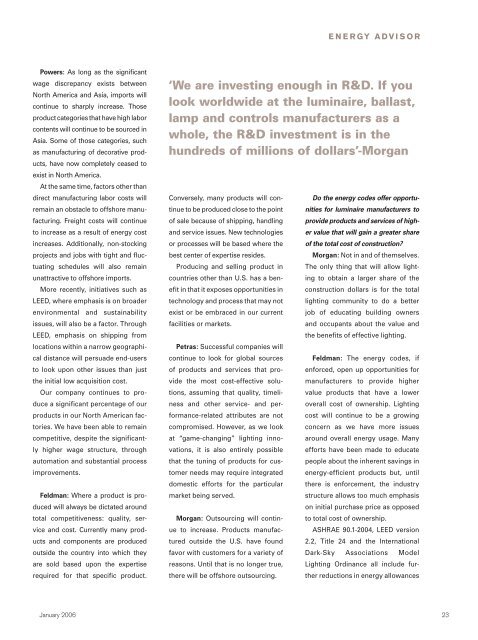COMMeMOratiVe ISSue - Illuminating Engineering Society
COMMeMOratiVe ISSue - Illuminating Engineering Society
COMMeMOratiVe ISSue - Illuminating Engineering Society
You also want an ePaper? Increase the reach of your titles
YUMPU automatically turns print PDFs into web optimized ePapers that Google loves.
E N E R GY A D V I S O R<br />
Powers: As long as the significant<br />
wage discrepancy exists between<br />
North America and Asia, imports will<br />
continue to sharply increase. Those<br />
product categories that have high labor<br />
contents will continue to be sourced in<br />
Asia. Some of those categories, such<br />
as manufacturing of decorative products,<br />
have now completely ceased to<br />
exist in North America.<br />
At the same time, factors other than<br />
direct manufacturing labor costs will<br />
remain an obstacle to offshore manufacturing.<br />
Freight costs will continue<br />
to increase as a result of energy cost<br />
increases. Additionally, non-stocking<br />
projects and jobs with tight and fluctuating<br />
schedules will also remain<br />
unattractive to offshore imports.<br />
More recently, initiatives such as<br />
LEED, where emphasis is on broader<br />
environmental and sustainability<br />
issues, will also be a factor. Through<br />
LEED, emphasis on shipping from<br />
locations within a narrow geographical<br />
distance will persuade end-users<br />
to look upon other issues than just<br />
the initial low acquisition cost.<br />
Our company continues to produce<br />
a significant percentage of our<br />
products in our North American factories.<br />
We have been able to remain<br />
competitive, despite the significantly<br />
higher wage structure, through<br />
automation and substantial process<br />
improvements.<br />
Feldman: Where a product is produced<br />
will always be dictated around<br />
total competitiveness: quality, service<br />
and cost. Currently many products<br />
and components are produced<br />
outside the country into which they<br />
are sold based upon the expertise<br />
required for that specific product.<br />
‘We are investing enough in R&D. If you<br />
look worldwide at the luminaire, ballast,<br />
lamp and controls manufacturers as a<br />
whole, the R&D investment is in the<br />
hundreds of millions of dollars’-Morgan<br />
Conversely, many products will continue<br />
to be produced close to the point<br />
of sale because of shipping, handling<br />
and service issues. New technologies<br />
or processes will be based where the<br />
best center of expertise resides.<br />
Producing and selling product in<br />
countries other than U.S. has a benefit<br />
in that it exposes opportunities in<br />
technology and process that may not<br />
exist or be embraced in our current<br />
facilities or markets.<br />
Petras: Successful companies will<br />
continue to look for global sources<br />
of products and services that provide<br />
the most cost-effective solutions,<br />
assuming that quality, timeliness<br />
and other service- and performance-related<br />
attributes are not<br />
compromised. However, as we look<br />
at “game-changing” lighting innovations,<br />
it is also entirely possible<br />
that the tuning of products for customer<br />
needs may require integrated<br />
domestic efforts for the particular<br />
market being served.<br />
Morgan: Outsourcing will continue<br />
to increase. Products manufactured<br />
outside the U.S. have found<br />
favor with customers for a variety of<br />
reasons. Until that is no longer true,<br />
there will be offshore outsourcing.<br />
Do the energy codes offer opportunities<br />
for luminaire manufacturers to<br />
provide products and services of higher<br />
value that will gain a greater share<br />
of the total cost of construction<br />
Morgan: Not in and of themselves.<br />
The only thing that will allow lighting<br />
to obtain a larger share of the<br />
construction dollars is for the total<br />
lighting community to do a better<br />
job of educating building owners<br />
and occupants about the value and<br />
the benefits of effective lighting.<br />
Feldman: The energy codes, if<br />
enforced, open up opportunities for<br />
manufacturers to provide higher<br />
value products that have a lower<br />
overall cost of ownership. Lighting<br />
cost will continue to be a growing<br />
concern as we have more issues<br />
around overall energy usage. Many<br />
efforts have been made to educate<br />
people about the inherent savings in<br />
energy-efficient products but, until<br />
there is enforcement, the industry<br />
structure allows too much emphasis<br />
on initial purchase price as opposed<br />
to total cost of ownership.<br />
ASHRAE 90.1-2004, LEED version<br />
2.2, Title 24 and the International<br />
Dark-Sky Associations Model<br />
Lighting Ordinance all include further<br />
reductions in energy allowances<br />
January 2006 23
















